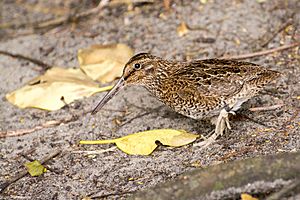Snares snipe facts for kids
Quick facts for kids Snares snipe |
|
|---|---|
 |
|
| A banded adult from the first translocation to Codfish Island / Whenua Hou from the Snares Islands. | |
| Conservation status | |
| Scientific classification | |
| Synonyms | |
|
The Snares Island snipe (Coenocorypha huegeli), also called the Snares snipe or tutukiwi in Māori, is a type of bird. It belongs to the sandpiper family, called Scolopacidae.
Contents
About the Snares Snipe
The Snares Island snipe is part of a group of birds in the Coenocorypha family. Scientists sometimes debated how it was related to other birds. It used to be thought of as a type of the Subantarctic snipe. But now, it is considered its own unique species.
The Reverend Henry Baker Tristram first described this bird in 1893. He named it Gallinago huegeli. The name huegeli honors a naturalist named Anatole von Hügel. The Māori name, "tutukiwi," means "little kiwi." This name is used because the bird looks and acts like a tiny kiwi.
What the Snares Snipe Looks Like
The snipe is a small, plump wader bird. It has patterns that help it blend in with its surroundings. Its feathers have bars, stripes, and spots in shades of brown. These colors range from light buffy-white to almost black. It also has stripes on its face and the top of its head.
This bird has a long bill, a short neck, and a short tail. Its outer tail feathers are narrow and stiff. This special tail helps the bird make a loud, roaring sound. This sound is part of its night-time "hakawai" aerial display.
Male and female snipes look similar. However, females are a bit larger. Females weigh about 116 grams, while males weigh about 101 grams. Female bills are around 57 mm long, and male bills are about 55 mm. Females also have olive-colored legs, while males have yellow legs. Young snipes are not as brightly colored.
Where the Snares Snipe Lives
The Snares snipe is only found on the Snares Islands/Tini Heke. This is a small group of islands south of New Zealand. The islands cover about 3.5 square kilometers. They are located about 200 km south of New Zealand in the Southern Ocean.
The snipe breeds on North East and Broughton Islands. It has also been seen on Alert Stack. Some snipes have been moved to Putauhinu Island. The bird likes to live on the moist ground under Olearia and Brachyglottis forests. It prefers areas with grass clumps, sedges, mat-forming plants, and Polystichum vestitum shield ferns.
Snares Snipe Behaviour
Edgar Stead visited the Snares Islands in 1947. He observed the snipe's behavior. When disturbed during the day, the snipe runs a short distance. Then it stops and quietly watches. They do not like to fly much during the day. If they do fly, it's usually only for a short distance. At night, they fly more easily and for longer distances.
Their main food seems to be worms. Snipes are often found near penguin colonies. Their egg-laying season starts in early December. Nests were found inside large clumps of Poa foliosa grass. These nests were about one foot above the ground. The nests were deep cups made of fine grass. They were about 9.5 cm wide and 7 cm deep.
Reproduction and Life Cycle
Most Snares snipes form monogamous pairs. This means they have one partner for breeding. They defend their breeding areas. Both parents share the job of incubating their two eggs. The nest is hidden in thick plants on the ground.
When the chicks hatch, they weigh about 14-18 grams. They are precocial and nidifugous. This means they are born quite developed and leave the nest soon after hatching. The male parent takes care of the first chick to leave the nest. The female parent looks after the second chick. The chicks stay with their parents for about eight weeks. The parents feed them for the first two weeks. The young snipes can fly when they are about 30 days old.
Feeding Habits
The Snares snipe eats many kinds of small invertebrates. These include annelids (like worms), amphipods, spiders, and insects. They find their food by using their long bills to probe in the soil and dead leaves on the ground.
Protecting the Snares Snipe
There are about 400 pairs of Snares snipes living on the Snares Islands. On April 16, 2005, thirty snipes were moved. They were taken from North East Island to Putauhinu Island. Putauhinu Island is 141 hectares in size. This move was done to create a backup population. This "insurance population" helps protect the species. It guards against the risk of land animals accidentally being brought to the Snares Islands. These new animals could hunt the snipes.
Putauhinu Island is near Stewart Island. It is close to Taukihepa/Big South Cape Island. Big South Cape Island was the last home for the South Island snipe. That species is now extinct. This shows how important it is to protect the Snares snipe.
See also
 In Spanish: Chochita de las Snares para niños
In Spanish: Chochita de las Snares para niños


